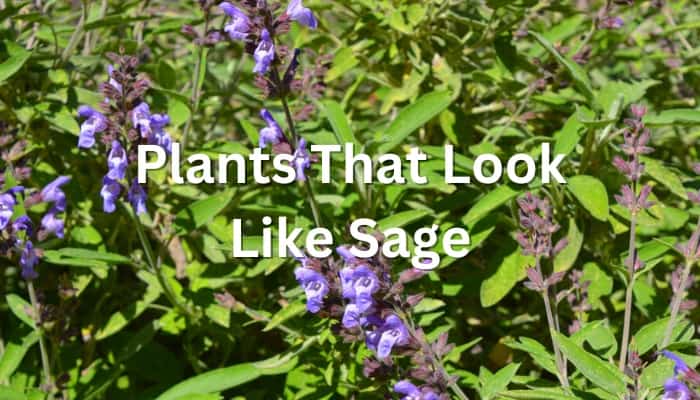Sage, with its warm and distinct aroma, adds a unique flavor to stuffings and other dishes. However, it would be even better if its appearance was just as recognizable.
There is a wealth of shrubs and wildflowers that look very similar to sage either in their flowers or foliage (or sometimes both).
Here are 15 sage doppelgangers and how they differ from the real thing.
1. Lamb’s Ear
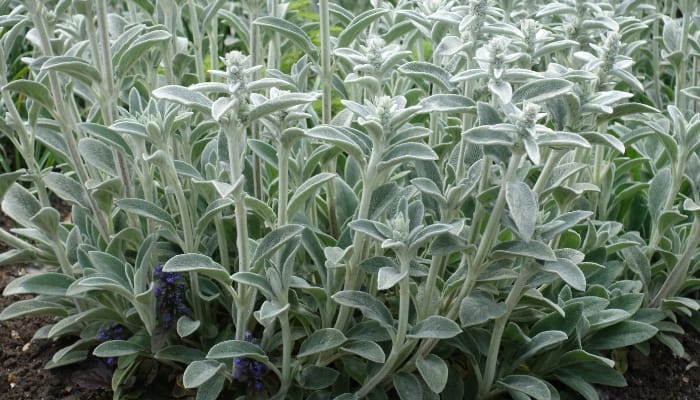
Also known as donkey’s ear, this dense ground cover is remarkably similar to sage with its slender, oblong leaves, clumping growth habit, and velvety texture. They even both reach a similar height at around 2 feet.
Where they differ though is that common sage leaves tend to have an olive green base and silvery “halo” of hairs while lamb’s ear foliage is often silvery-white.
Lamb’s ear also emits an unpleasant bitter scent compared to the floral, lavender-like notes of sage.
2. Mint

Some mint varieties such as Buddleia and apple mint have soft, hairy leaves similar to sage’s downy foliage. Their leaves also have a similarly wrinkled, puckered texture.
There are a fair few differences though. Mint of course carries a distinctive menthol aroma. The leaves are also a deeper, lusher green compared with sage and have toothed, not smooth, edges.
Mint flowers tend to grow in tall, dense flower spikes instead of stubby spikes with sparsely dotted blooms
3. English Lavender
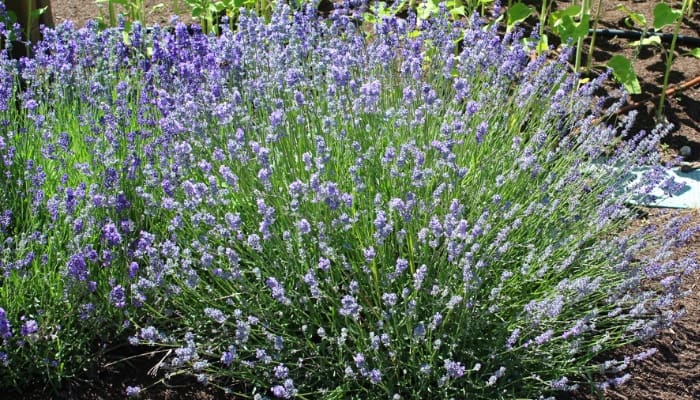
From afar the blueish-purple flower spikes of English lavender can certainly be mistaken for sage. Confusingly, sage has fragrant hints of lavender too!
An obvious tell is in the leaves – while English lavender foliage is grayish-green and downy, the leaves are very narrow, thin, and strap-like. This lavender also grows taller than sage at a maximum potential height of 3 feet.
4. Amaranth

Amaranth looks somewhere between sage and mint with its broad and wrinkled leaves that can be covered in tiny hairs, lending to a velvety appearance.
Unlike sage leaves, which are downy to the point of masking the vein detail, amaranth leaves have prominent veins and come in colors ranging from gold and green to deep red and purple.
Another helpful giveaway here is the height — this edible weed can grow taller than 6 feet!
5. Lead Plant
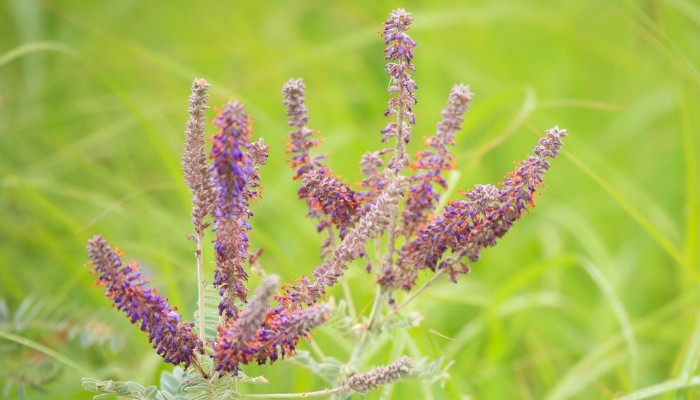
Nicknamed prairie shoestring, the lead plant has narrow oblong leaves covered in dense hairs that give them a grayish appearance. This shrub also has spikes of small purplish-blue flowers.
Unlike sage flowers though, lead plant flower spikes are very long and slender to the point of coiling and drooping above the foliage.
The blooms along the spike are also tiny and compact compared to sage’s shorter spikes and spread-out flower arrangement.
6. Catmint

At first glance, catmint’s wrinkled gray-green leaves and spikes of blue and pale purple flowers appear quite similar to sage.
Up close though, catmint leaves have more obvious vein detailing and jagged margins. The flowers are also fairly different.
Catmint has two-lipped mauve to blueish flowers with scalloped petals and a dark-speckled pattern in the center.
7. Blue Mist Spirea
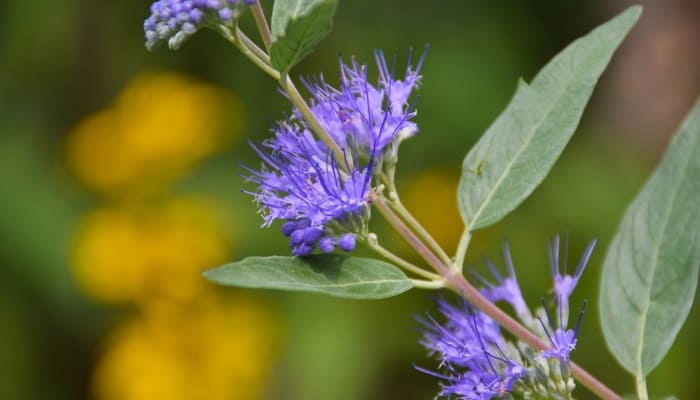
Also known as the bluebeard plant, this mounding shrub is named for its foliage that almost resembles mist or smoke from afar. It also emits a warm aroma when brushed against that is not dissimilar to sage.
Though the leaves are arranged in a similar way, blue mist spirea foliage is deeper green with a slightly glossy texture. Its violet-blue flowers grow in clusters very close to the stem too and have a delicate, feathery look.
8. Hyssop
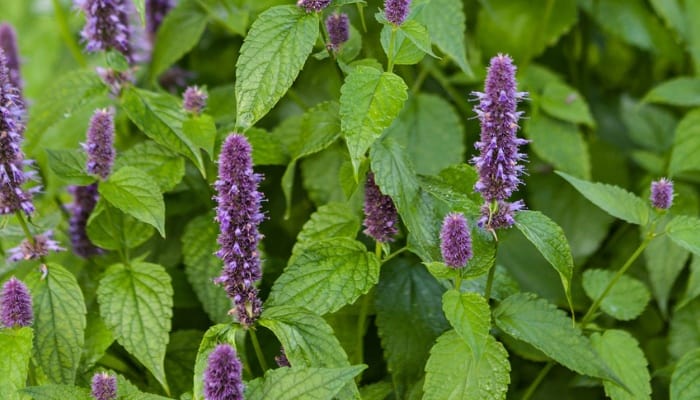
Like sage, hyssop has elliptical leaves that grow in opposite pairs along its square stem. It also produces spikes dotted with small two-lipped flowers.
While hyssop leaves also produce tiny dense hairs, they are noticeably more narrow. The flowers can also be red, pink, white, purple, or dark blue, while common sage blooms are typically only blue and pale purple.
9. Catnip

The textured grayish-green leaves covered in fine hairs may have you mistaking catnip for sage. The showy lavender flowers can be a red herring too.
However, the foliage of catnip is broader and heart-shaped compared to sage’s slender oblong leaves and has saw-toothed edges.
Compared with sage’s dense growth, catnip also has a leggy habit of long spreading stems and can reach up to 3 feet.
10. False Indigo
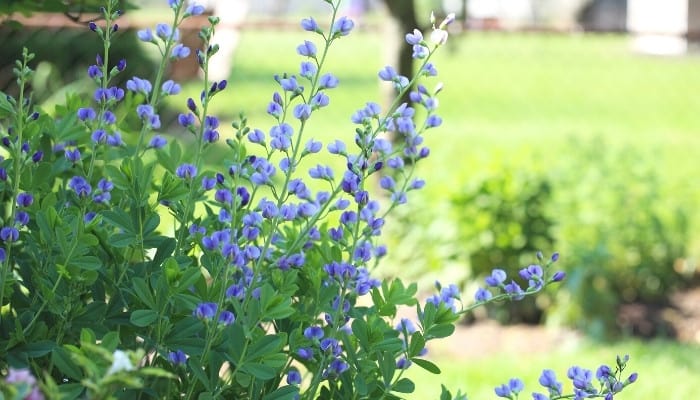
This dense shrubby flowering plant produces similarly oblong, smooth leaves in a blue-green or felted gray-green color. However, false indigo flowers don’t look like those of sage, though they are arranged in the same way.
The flower spikes alone can reach up to 2 feet in length, and the blooms are gorgeously rich indigo instead of pale blue.
The blooms themselves are also broader and pea-shaped compared to the tubular, two-lipped sage flowers.
11. Lamium

This spreading ground-cover plant is grown for its foliage, which bears attractive markings and has a frosted grayish-green appearance.
It also has short, stubby flower spikes of tubular blooms like sage, but these can also be yellow, white, or peach-colored.
The foliage, though varied, is typically more mint-like in appearance with toothed edges and more prominent veins compared to sage.
12. Blue Vervain

This distinctive wildflower has square hairy stems with equally downy spear-shaped whitish-green leaves (with toothed edges though).
The flowers are even the same shade as sage blooms, although these aren’t displayed in the same way at all.
Blue vervain flower spikes are brownish-purple with a tightly packed, almost pencil-like form and feature a ring or “skirt” of pale blue four-petal flowers around the middle of the spike.
13. Heather

Similar to English lavender, heather has clusters of fine, finger-like foliage that appear feathery from afar. The foliage can range from yellowish-green to dark and powdery-green with some varieties sporting downy fuzz.
The flowers of heather are borne on similar spike shapes to sage and come in pale purple colors, although they tend to be more bell-shaped.
14. Sagebrush

With a name like sagebrush, surely this is in the sage family? Not even close. Sagebrush actually belongs to the daisy plant family.
Like sage, it has powdery-green leaves, but very unlike sage, this densely branched shrub has super long and narrow brush-like foliage with scalloped edges and grows up to 9 feet tall.
15. Speedwell

There are around 450 different species of this clump-forming flowering plant, and many carry a few monikers of sage.
Some have stubby flower spikes of blue or purplish flowers, and others have grayish-green, lamb’s ear-like leaves.
Notably, speedwell leaves tend to be toothed or far narrower than sage foliage. Their bloom display is often denser and more showy. Most noticeable of all — a speedwell plant doesn’t have a fragrance.
How To Identify Sage
- Leaves have a rough, wrinkled appearance and can be 2½ to 5 inches long and usually 1 inch wide.
- Variegated sage types can feature silvery-white or grayish-green leaves, but foliage is commonly olive-green in color.
- Typically has an earthy, herbaceous aroma with floral hints of lavender. Some varieties may have a sweeter or pine-like scent.
- Sends out mauve or bluish flowers early to mid-summer on short spikes with tubular, two-lipped flowers arranged fairly sparsely up the stem.
- Typically grows 2 feet tall and wide, and stems become woody with maturity.
- Sage is evergreen, so it retains its leaves all year round.
- Stems are greenish purple and are covered in fine short hairs.
Sage Varieties
Did you know that there are hundreds of sage varieties? Below, we’ve listed a few you might across when visiting your local garden center.
Purple Sage
Also known as desert sage due to its amazing resilience in hotter regions, purple sage produces beautiful lavender-blue flowers and goes great in stew, poultry, and pork dishes!
Autumn Sage
This stunning reddish-pink sage produces an abundance of vibrant flowers long into fall and pairs wonderfully with late-season dishes like stuffing and winter squash.
Scarlet Sage
This uncommon variety features stunning red blooms that are sure to be a hit with pollinators. Its slightly sweet licorice flavor makes scarlet sage a winning combination in herbal teas or to give salad dishes a little zing!
Azure Blue Sage
The sky-blue brush-like blossoms of this sage provide a stunning contrast to nearby shrubs in your landscape. Make use of its strongly aromatic scent in a soothing essential oil spray for instant calm!

